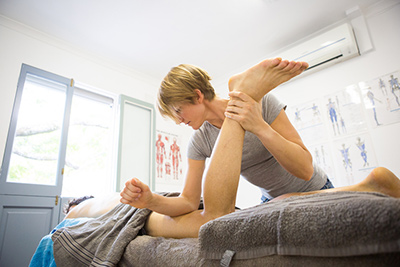
By Eric Stephenson, LMT
Are you a weekend warrior, self-proclaimed athlete, or someone who just generally likes to push themselves a little too hard at the gym? Sports massage might be just what the body ordered.
We all know physical activity generates positive health benefits for your body, but it can also create negative effects that arise when you push past your physical limit. That’s when you show up on our massage tables with injuries related to this overexertion.
The Athlete in All of Us
Olympic, collegiate, and professional athletes utilize sports massage therapy to mitigate and recover from sports injuries. Oftentimes, teams employ and even travel with a massage therapist. And research continues to show what athletes already know—massage has a positive effect on athletes and their performance.1
The benefits of sports massage extend beyond professional athletes to anyone who participates in regular exercise. Whether it be golf, tennis, or ballroom dancing, if you engage in physical exercise, sports massage therapy is a good option for you. And, if you suffer from a nagging injury or orthopedic condition that keeps you from performing at your best, sports massage is especially helpful.
Types of Sports Massage
Did you know that about 65 percent of injuries—both athletic and lifestyle-related—come from overuse of the muscles? The other 35 percent are caused by true trauma.2 Sports massage is a customized, targeted approach to improving performance while decreasing pain and various forms of limitation in the body. While sports massage is meant to be customized for every client and every sport, there is a general approach that can be implemented for those who fall into any of the following three possible categories.
General Sports Massage
Typically, this type of sports massage is a full-body massage approach customized for clients involved in sports like football, tennis, and golf, as well as for clients who are looking to increase the ease, quality, and range of motion of their body movements. This type of sports massage may also be used to prepare the body for physical activity. During this massage, specific attention is often targeted to areas requested by the client.
Injury-Focused Sports Massage
This approach generally falls outside a full-body approach to target specific movement conditions that include plantar fasciitis, low-back pain, tennis elbow, golfer’s elbow, and other common sports injuries. This approach could include active engagement from the client or passive movement techniques. Falling outside a full-body approach allows the client and massage therapist time to focus on two or three areas of the body with specific, desired therapeutic outcomes.
Pre- and Postevent Sports Massage
This approach is customized to either prepare the athlete for immediate, high-intensity activity, or to help them recover. There are two basic subsets of this type of sports massage:
• Pre-event: This approach finds the sports massage therapist avoiding deep pressure on the athlete and instead employing lighter, faster movements to energize the nervous system rather than relax it. This would typically fall into a full-body approach with gentle joint movements and stretching.
• Postevent: This session is intended to help calm the nervous system, reduce pain, and help restore muscles to their normal resting length. This would typically fall into a full-body approach with gentle movements and light stretching.
Who Should Get a Sports Massage?
Anyone who is actively involved in a movement-oriented sport could see great benefits from regular massages, and sports massage specifically. In addition, if you suffer from any of the following ailments, you should ask your massage therapist about injury-focused sports massage:
• Golf elbow
• Frozen shoulder
• Low-back pain
• Pain while running
• Plantar fasciitis
• Shin splints
• Tennis elbow
But Is Sports Massage Therapy For Me?
I once had a client who complained about pain from playing nine rounds of golf. I began to inquire about his warm-up routine and found he was contracting the muscles of his shoulder, when what they really needed was to be lengthened and stretched. We looked at a series of his movements to help identify pain points and improve his execution of those movements. This consultation resulted in him shifting to the correct body movements and, in turn, eliminated his ongoing chronic pain. He was ecstatic that this simple change of pattern, along with regular sports massage, got him back to the game he loved … pain-free!
There are many benefits of sports massage. Pain relief, injury recovery, and increased somatic awareness are a few of the most important. Your massage therapist is here to help you determine optimal movements for your sport of choice so you can avoid future injury, get past acute, sub-acute, or chronic injuries, and improve the body’s range, quality, and ease of motion.
Notes
1. Science Daily, “Massage Reduces Inflammation and Promotes Growth of New Mitochondria Following Strenuous Exercise, Study Finds,” February 1, 2012, accessed September 2018,
www.sciencedaily.com/releases/2012/02/ 120201141710.htm.
2. Mark Verstegen, Core Performance: The Revolutionary Workout Program to Transform Your Body and Your Life (Rodale, 2005): 56.
This article was originally published in the Autumn 2018 issue of Body Sense magazine.
Eric Stephenson is chief wellness officer for Elements Massage, one of the fastest-growing therapeutic massage franchises in the nation, which offers Himalayan Salt Stone Massages and recently launched AromaRitual, the brand’s newest line of exclusive aromatherapy treatments. Elements Massage was recognized as part of Entrepreneur’s 2018 Franchise 500 Ranking. In addition, Stephenson is cofounder of imassage, Inc. and a board member of the International Spa Association (ISPA).